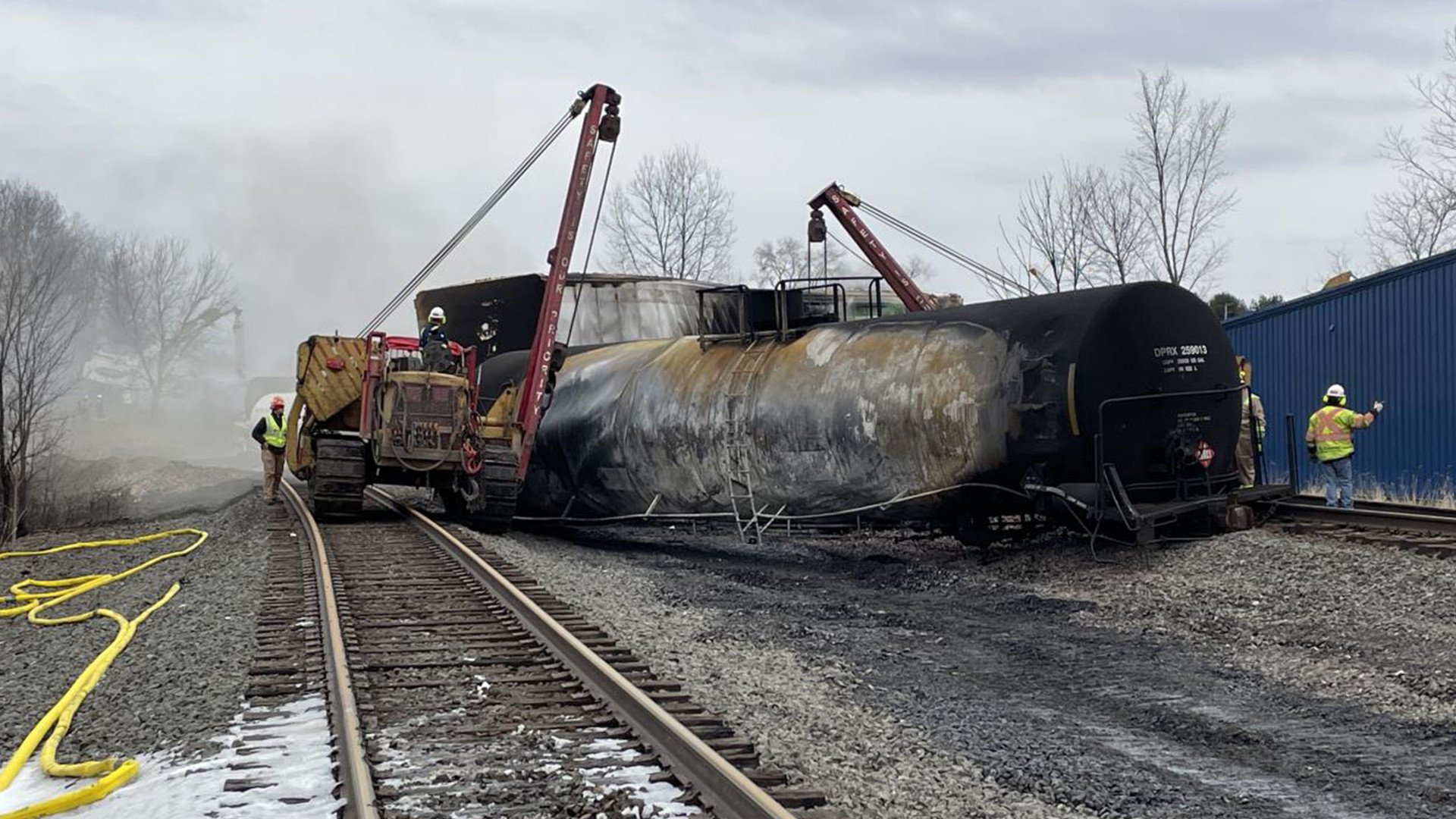Toxic Chemical Residue From Ohio Train Derailment Remains In Buildings

Table of Contents
The Types of Toxic Chemicals Present and Their Persistence
The derailment released a cocktail of hazardous substances, many of which are known to persist in the environment and within building materials. Understanding the specific chemicals and their properties is crucial to assessing the risk.
Vinyl Chloride and its Long-Term Effects
Vinyl chloride, a known carcinogen, was a significant component of the spilled materials. Its volatile nature means it can easily penetrate building materials and persist for extended periods.
- Adherence to Surfaces: Vinyl chloride can adhere to both porous materials like wood and drywall, and non-porous surfaces like metal and glass, making decontamination challenging.
- Off-gassing: Even after the initial release, vinyl chloride can continue to off-gas from contaminated surfaces, leading to prolonged exposure for building occupants.
- Health Consequences: Long-term exposure to vinyl chloride is linked to an increased risk of various cancers, including liver cancer, as well as respiratory problems and liver damage.
Other Hazardous Chemicals and Their Impact
Beyond vinyl chloride, other hazardous chemicals released during the derailment, such as butyl acrylate, ethylene glycol monobutyl ether, and others, pose significant health risks.
- Butyl Acrylate: This chemical can cause skin and eye irritation, respiratory problems, and allergic reactions. Its persistence in building materials varies depending on the material’s porosity and the chemical's concentration.
- Ethylene Glycol Monobutyl Ether: Exposure can lead to central nervous system depression, kidney damage, and reproductive toxicity. Detection and remediation of this chemical can also prove complex due to its solubility in water and various building materials.
- Varied Absorption: Different building materials absorb and retain these chemicals at different rates, making a uniform remediation approach challenging. Some materials may trap chemicals more effectively, leading to persistent contamination.
- Detection Challenges: The low concentrations of some chemicals make detection difficult, requiring specialized and expensive testing equipment.
The Extent of Contamination and Testing Challenges
Determining the precise geographic spread of contamination and the level of chemical residue in buildings presents significant challenges.
Geographic Spread of Contamination
The impact area extends beyond the immediate vicinity of the derailment site, raising concerns about the broader environmental and public health consequences.
- Affected Areas: Specific towns and neighborhoods near East Palestine, Ohio, have reported noticeable impacts, but the full extent of the affected area remains under investigation. Air and water testing results have been inconsistent and debated, leading to ongoing uncertainty.
- Testing Inconsistencies: Variations in testing methodologies, sampling techniques, and the lack of standardized protocols have led to inconsistencies in reported levels of contamination. This makes accurate assessment and effective remediation difficult.
Difficulties in Testing for Residual Chemicals
Detecting trace amounts of chemicals in various building materials poses a significant analytical hurdle.
- Technological Limitations: Current testing technologies may not be sensitive enough to detect very low concentrations of certain chemicals, especially within complex building materials.
- Cost and Accessibility: Comprehensive testing is often expensive and may not be readily accessible to all residents, particularly those with limited financial resources.
- Long-Term Effects Research: Further research is needed to fully understand the long-term effects of low-level exposure to these chemicals, compounding the difficulty of risk assessment.
Health Concerns and Long-Term Impacts on Residents
Exposure to the toxic chemical residue from the Ohio train derailment raises serious health concerns for residents, both in the short and long term.
Acute and Chronic Health Effects
Residents have reported a range of symptoms, suggesting both acute and chronic health impacts.
- Acute Effects: These include headaches, nausea, respiratory irritation, skin rashes, and eye irritation.
- Chronic Effects: Long-term exposure could lead to more serious health problems, including various cancers, respiratory illnesses, neurological disorders, and reproductive issues. Further research and longitudinal studies are necessary to fully understand the chronic impacts.
The Psychological Impact on the Community
The uncertainty surrounding the long-term health consequences and the lack of clear communication from authorities have resulted in significant psychological distress among residents.
- Mental Health Impacts: Stress, anxiety, fear, and post-traumatic stress disorder (PTSD) are common among residents coping with the aftermath of the derailment.
- Lack of Support: The absence of readily available mental health services and clear communication channels further exacerbates the psychological burden on the community.
Mitigation Strategies and Recommendations
Effective mitigation strategies are crucial to minimize the long-term health risks associated with the persistent toxic chemical residue.
Professional Cleaning and Remediation
Professional decontamination of affected buildings is essential to remove or neutralize the hazardous chemicals.
- Cleaning Methods: Methods may include specialized cleaning solutions, air filtration systems, and the removal and disposal of severely contaminated materials.
- Proper Disposal: Contaminated materials must be properly disposed of according to environmental regulations to prevent further contamination.
Governmental Response and Future Prevention
Governmental agencies play a crucial role in coordinating remediation efforts, ensuring ongoing health monitoring, and implementing preventative measures.
- Improved Response: The current governmental response needs critical evaluation and improvements to ensure effective communication, access to testing and remediation, and long-term health monitoring.
- Strengthened Regulations: Stricter regulations and enhanced safety protocols for the transportation of hazardous materials are vital to prevent future derailments and similar incidents.
Conclusion
The lingering presence of toxic chemical residue from the Ohio train derailment represents a serious and ongoing threat to public health and the environment. The challenges in testing, remediation, and understanding the long-term health impacts highlight the need for a coordinated and comprehensive response. Stay informed, advocate for comprehensive testing and remediation, and don't hesitate to seek professional assistance if you suspect contamination in your building. Protecting your health and the health of your community requires continued vigilance against the invisible dangers of toxic chemical residue from this devastating event. The long-term consequences of this incident underscore the urgent need for stricter regulations and improved safety protocols for the transportation of hazardous materials to prevent future catastrophes and the lasting impact of toxic chemical residue.

Featured Posts
-
 Fatih Erbakandan Kibris A Dair Net Bir Mesaj Sehitlerimizin Mirasi
May 19, 2025
Fatih Erbakandan Kibris A Dair Net Bir Mesaj Sehitlerimizin Mirasi
May 19, 2025 -
 Trump And Putin To Discuss Ukraine After Diplomatic Impasse
May 19, 2025
Trump And Putin To Discuss Ukraine After Diplomatic Impasse
May 19, 2025 -
 Morre Ivan Kley Pai Do Cantor Vitor Kley Uma Perda Inesquecivel
May 19, 2025
Morre Ivan Kley Pai Do Cantor Vitor Kley Uma Perda Inesquecivel
May 19, 2025 -
 Eurovision 2025 United Kingdoms 19th Place Finish Analyzed
May 19, 2025
Eurovision 2025 United Kingdoms 19th Place Finish Analyzed
May 19, 2025 -
 New Mexico Governor Race Deb Haalands Candidacy Announcement
May 19, 2025
New Mexico Governor Race Deb Haalands Candidacy Announcement
May 19, 2025
